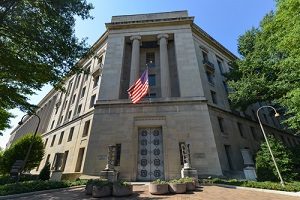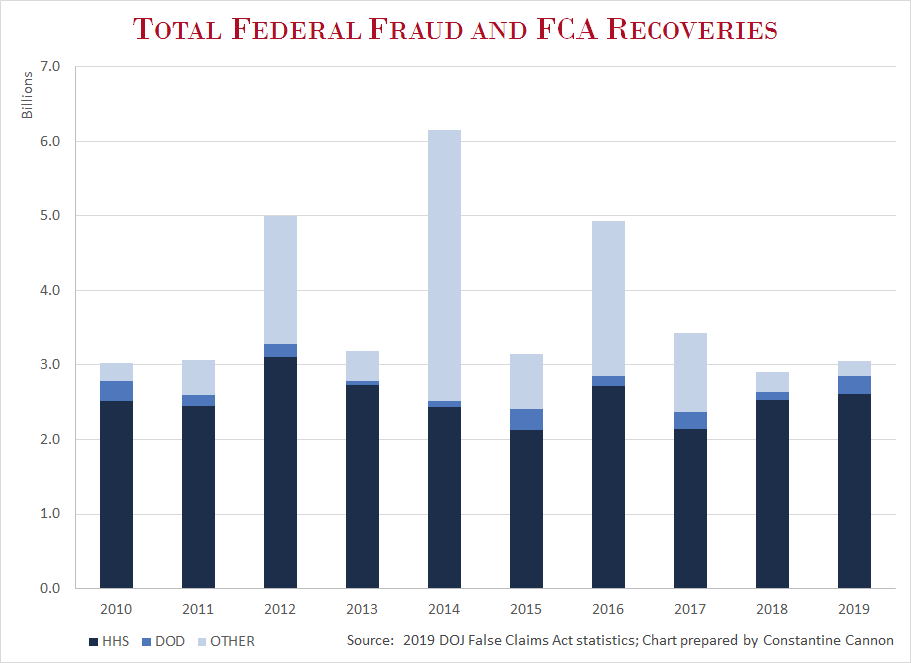DOJ 2019 Fraud Statistics Tell Story of the Critical Role of Whistleblowers

The Department of Justice released its annual report of civil recoveries for fraud and false claims against the U.S., showing recoveries over $3 billion in settlements and judgments for the fiscal year ending September 2019. The data released by DOJ show the critical role that whistleblowers play in securing these recoveries for the government: of the $3 billion recovered, over $2.2 billion – 72% – was recovered in cases initiated by whistleblowers under the False Claims Act. And, as in prior years, healthcare fraud accounted for the majority of funds recovered: of the $3 billion recovered, $2.6 billion was attributed to healthcare fraud.
The year had some blockbuster recoveries – each, a whistleblower case – which DOJ called out in its press release:
- Pharmaceutical company Reckitt Benckiser Group plc, which paid a total of $1.4 billion to resolve both criminal and civil claims related to the marketing of its drug Suboxone. $500 million of this total settlement was paid in resolution of civil claims by the U.S.; the remainder was paid to states, as criminal forfeiture, and in resolution of claims by the FTC. Although it appears that “only” the $500 million is included in the DOJ statistics, that still means that the Reckitt Benckiser settlement represents 16% of the total.
- In another opioid-related settlement, Insys Therapeutics paid $195 million to resolve civil claims related to its marketing of its painkiller Subsys; this represents 6% of the total recovery.
- Multiple defendants settled claims first brought by a whistleblower represented by Constantine Cannon alleging that they rigged bids on fuel sales to the U.S. military in South Korea; the DOJ report states that five companies paid over $162 million to resolve the civil claims, another 5% of the total.
For more information about top settlements in calendar year 2019, see our Top Ten Lists.
The Role of Whistleblowers – and the Rewards for Whistleblowers
In announcing the figures, Assistant Attorney General Jody Hunt said that “Whistleblowers continue to play a critical role identifying new and evolving fraud schemes that might otherwise remain undetected,” and “taxpayers have benefited greatly from these individuals who are often required to make substantial sacrifices to bring these schemes to light.”
Whistleblowers can pursue fraud against the U.S. by filing qui tam actions under the False Claims Act. The importance of whistleblower qui tam cases over the years can be easily seen:

The False Claims Act provides that successful whistleblowers are eligible to receive a share of the government’s recovery – up to 30% if the U.S. has not intervened to litigation the action, and generally between 15 and 25% if the government intervenes. In 2019, the U.S. paid out whistleblower rewards totaling $265 million. This number is the lowest in the last ten years, and, for whistleblowers and their lawyers, it may come as a disappointment. The relatively low award number is hard to square with the continued strength in total recoveries, and the continued substantial role of whistleblowers in securing those recoveries. A more detailed look, however, offers some explanation, and reason to hope that reported whistleblower recoveries will increase.

Whistleblower rewards are not always determined and paid at the same time as the settlement. The determination of whistleblower rewards may occur in a different reporting year than the recovery itself for many reasons, from the simply logistical to the more complicated negotiation or litigation of issues regarding a whistleblower’s entitlement to certain proceeds, public disclosure, multiple relators, the whistleblower’s role in the underlying wrongdoing, and more. When DOJ releases each year’s statistics, DOJ updates recovery and reward numbers in prior years as well. One reason to do this would be to account for settlement recoveries and whistleblower rewards that straddle reporting years.
For example, when DOJ reported its 2018 statistics last year, whistleblower rewards were reported at $301 million; in the current DOJ 2019 report, those 2018 whistleblower reward numbers have been updated to $342 million. The changes to reported whistleblower rewards in FY2017 are even more striking over the years: In FY 2017, they were first reported at $393 million; they were updated to $478 million in the 2018 report; now, FY2017 whistleblower rewards are listed at $536 million. That is, since FY2017 whistleblower rewards were first reported, an additional $143 million has been added to them.
Therefore, while the reported decline in whistleblower rewards is certainly a cause for concern, future whistleblower rewards on this year’s recoveries should, over time, abate some of that concern. We will watch for such changes in future year reports.
Moreover, the global figures say little about individual cases. With the obvious importance of whistleblowers in securing recoveries, whistleblowers and their lawyers will continue to press DOJ to recognize that importance through appropriate rewards that are consistent with statutory requirements. Experienced whistleblower attorneys can help potential whistleblowers weigh their options and understand the process and possible outcomes of filing a qui tam complaint. (See our page I think I Have a Whistleblower Case)
Healthcare Continues to Dominate Recoveries
One feature of DOJ’s recoveries has remained consistent: healthcare fraud dominates. DOJ reports that 85% of its recoveries occurred in cases involving fraud in government healthcare programs including Medicare, Medicaid, and Tricare. As noted by DOJ, healthcare fraud not only harms taxpayers, it often puts patients at risk, including through the provision of unnecessary or inappropriate treatment and medications.

It was a strong year for recoveries outside of healthcare: procurement, including Department of Defense cases, and federal programs. While few years can match the years in which the government secured substantial settlements from institutions that contributed to the 2007-2008 mortgage crisis (see 2012, 2014, and 2016), it is encouraging that non-healthcare recoveries in 2019 showed an increase from 2018.
There’s More to the Story: What’s Missing from the DOJ Report
As we have cautioned before, the DOJ Annual Report, while useful, is missing critical data that can help paint a more complete picture of the government’s enforcement efforts, and the role of whistleblowers in those efforts. In addition to the time lag in DOJ’s ability to report all whistleblower awards attributable to this year’s recoveries, important categories of recovery and areas where whistleblowers can make a difference are outside the scope of the report. These areas include:
- Criminal penalties and restitution awards, a particularly notable category this year, given the criminal recoveries in Reckitt Benckiser and other cases.
- Recoveries in cases delegated to United States Attorneys’ offices, instead of those handled by the Civil Division.
- Recoveries by state and local governments.
- Recoveries by the government for fraud against non-governmental entities, such as by the Securities and Exchange Commission or Commodity Futures Trading Commission.
- Tax fraud and underpayment.
Our Whistleblower Insider blog regularly analyzes the reports of federal agencies that work with whistleblowers, and we have already written this year about the annual reports from the whistleblower programs of the SEC, CFTC, and IRS. If you would like more information about these annual reports or have questions about bringing a whistleblower claim, please contact us for a confidential conversation.
Read More:
- The False Claims Act
- Healthcare Fraud
- Government Contract Fraud
- DOJ Enforcement Actions
- Top-10 Lists of Fraud and Whistleblower Cases
- I think I have a whistleblower case
- The Constantine Cannon Whistleblower Team
- Contact Us for a Confidential Consultation
Tagged in: FCA Federal, Importance of Whistleblowers, Statistics,